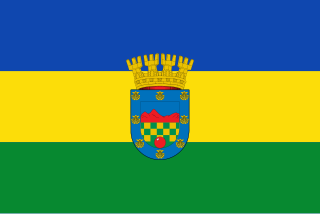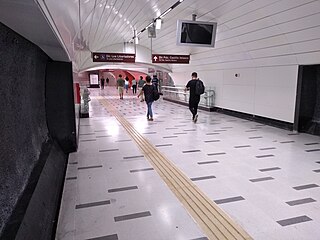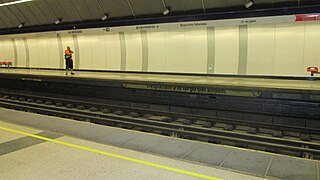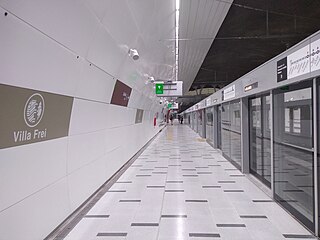
Santiago, also known as Santiago de Chile, is the capital and largest city of Chile and one of the largest cities in the Americas. It is located in the country's central valley and is the center of the Santiago Metropolitan Region, which has a population of seven million, representing 40% of Chile's total population. Most of the city is situated between 500–650 m (1,640–2,133 ft) above sea level.

The Santiago Metro is a rapid transit system serving the city of Santiago, the capital of Chile. It currently consists of seven lines, 143 stations, and 149 kilometres (92.6 mi) of revenue route. The system is managed by the state-owned Metro S.A. and is the first and only rapid transit system in the country.

Quilicura is a commune of Chile located in capital Santiago. Founded in 1901, it was originally a satellite city on what were then the outskirts of the city of Santiago, but as urban sprawl has set in it is now quickly urbanizing from what was recently prime agricultural land.

Plaza de Armas is a transfer station between the Line 3 and Line 5 of the Santiago Metro. It is located under the Plaza de Armas of Santiago. The Line 5 station was opened on 3 March 2000 as part of the extension of the line from Baquedano to Santa Ana. The Line 3 station was opened on 22 January 2019 as part of the inaugural section of the line, from Los Libertadores to Fernando Castillo Velasco.

Manquehue is an underground metro station on the Line 1 of the Santiago Metro, in Santiago, Chile. It is part of the 3.8 kilometres (2.4 mi) eastern extension of the Line 1. The station was opened on 7 January 2010 as part of the extension of the line from Escuela Militar to Los Dominicos,

Plaza de Maipú is an underground metro station on Line 5 of the Santiago Metro, in Santiago, Chile. The station is located under the Plaza de Armas of Maipú. It was formerly the deepest station in the Santiago Metro system at 28 metres (92 ft) deep. However, this has since been surpassed by the Line 3 platforms at Puente Cal y Canto station. The station was opened on 3 February 2011 as the southwestern terminus of the extension of the line from Pudahuel to Plaza de Maipú.

Irarrázaval is a transfer station between the Line 3 and Line 5 of the Santiago Metro. The station is so named due to its location beneath Avenida Irarrázaval, a main road of the commune of Ñuñoa, which in turn was named after the Chilean lawyer and politician Manuel José Yrarrázaval Larraín. The Line 5 station was opened on 5 April 1997 as part of the inaugural section of the line, from Baquedano to Bellavista de La Florida. The Line 3 station was opened on 22 January 2019 as part of the inaugural section of the line, from Los Libertadores to Fernando Castillo Velasco. Construction of the 6.5 km tunnel between Irarrázaval and Fernando Castillo Velasco was completed in 2017 on a budget of 145 million euro.

Santiago Metro Line 1 is the oldest of the seven existing rapid transit lines that make up the Santiago Metro system. Being its busiest, it has a total of 27 stations along its 19.3 km (12.0 mi) length, constructed almost entirely underground, and is located primarily along the axis formed by the Avenida Libertador General Bernardo O'Higgins, Providencia Avenue and Apoquindo Avenue.

Santiago Metro Line 2 is one of the seven rapid transit lines that currently make up the Santiago Metro network in Santiago, Chile. It has 26 stations and 25.9 km (16.1 mi) of track. The line intersects with Line 1 at Los Héroes, with the Line 3 at Puente Cal y Canto, with Line 4A at La Cisterna, with Line 5 at Santa Ana, and Line 6 at Franklin. It will also intersect with the future Line 7 and Line 9 at Puente Cal y Canto. Its distinctive colour on the network line map is banana yellow.

Santiago Metro Line 4 is one of the seven lines that currently make up the Santiago Metro network in Santiago, Chile. It has 23 stations and 23.9 km (14.9 mi) of track. The line intersects with Line 1 at Tobalaba, with Line 3 at Plaza Egaña at northeast, and with Line 4A at Vicuña Mackenna and with Line 5 at Vicente Valdés in southeast. It will also intersect with the futures Line 8 at Macul and Line 9 at Plaza de Puente Alto. Its distinctive colour on the network line map is blue.

Santiago Metro Line 5 is one of the seven lines that currently make up the Santiago Metro network in Santiago, Chile. It has 30 stations and 29.7 km (18.5 mi) of track. The line intersects with Line 1 at Baquedano station and San Pablo station, with Line 2 at Santa Ana station, with the Line 3 at both Plaza de Armas station and Irarrázaval station, with Line 4 at Vicente Valdés station, and with line 6 at Ñuble station. It will also intersect and the future Line 7 at Baquedano station. Its distinctive colour on the network line map is green.

Las Mercedes is an underground metro station located on Line 4 of the Santiago Metro, in Santiago, Chile. It lies opposite Concha y Toro Avenue between Independencia Street and Domingo Tocornal Avenue. The station was opened on 30 November 2005 as part of the inaugural section of the line between Vicente Valdés and Plaza de Puente Alto.

Line 3 is a rapid transit line of the Santiago Metro. Traveling from La Reina in the east towards the center, and Quilicura in the North, Line 3 was originally intended to open in the late 1980s, but the 1985 Algarrobo Earthquake hampered its construction, and a subsequent urban explosion in Puente Alto and Maipú further put its construction on hold, until in the early 2010s construction started. The first phase of the project includes 18 stations, which were completed and opened to the public on 22 January 2019 at a cost of US$1.79 billion. The second phase, composed of a three-station extension towards the main square of Quilicura, which was inaugurated on September 25, 2023 with a total project cost of US$378 million. Its distinctive color on the network line map is chocolate brown.

Laguna Sur station is an underground metro station on the Line 5 of Santiago Metro network, in Santiago, Chile. It is located underneath the junction of Teniente Cruz Avenue with Laguna Sur Street, in the commune of Pudahuel between Las Parcelas station and Barrancas station.

Barrancas is an underground metro station on Line 5 of the Santiago Metro network in Santiago, Chile. It is located underneath the junction of Teniente Cruz Avenue and General Bonilla Avenue on the border of the communes of Pudahuel and Lo Prado, between Laguna Sur station and Pudahuel station. It also lies parallel to the Route 68 highway which connects Santiago with Valparaíso and Viña del Mar, and the highway crosses over the underground metro line. The station has disabled access.

Plaza de Puente Alto is an underground metro station and the southern terminal station of Line 4 of the Santiago Metro network, in Santiago, Chile. The station is located under the square of the same name, Plaza de Puente Alto, parallel to Concha y Toro Avenue at the junction with Manuel Rodríguez avenue in the commune of Puente Alto. The station was opened to the public on November 30, 2005 as part of the inaugural section of the line between Vicente Valdés and Plaza de Puente Alto.

Villa Frei is an underground metro station of Line 3 of the Santiago Metro network, in Santiago, Chile. It is an underground, between the Chile España and Plaza Egaña stations on Line 3. It is located at the intersection of Irarrázaval Avenue with Ramón Cruz Avenue. The station was opened on 22 January 2019 as part of the inaugural section of the line, from Los Libertadores to Fernando Castillo Velasco.

Chile España is an underground metro station of Line 3 of the Santiago Metro network, in Santiago, Chile. It is an underground, between the Ñuñoa and Villa Frei stations on Line 3. It is located at the intersection of Irarrázaval Avenue with Chile España Avenue. The station was opened on 22 January 2019 as part of the inaugural section of the line, from Los Libertadores to Fernando Castillo Velasco.

Ferrocarril is an underground metro station of Line 3 of the Santiago Metro network, in Santiago, Chile. It is an underground, between the Lo Cruzat and Los Libertadores stations on Line 3. It is located at the intersection of Manuel Antonio Matta Avenue with Pasaje 4.

Lo Cruzat is an underground metro station of Line 3 of the Santiago Metro network, in Santiago, Chile. It is an underground, between the Plaza Quilicura and Ferrocarril stations on Line 3. It is located at the intersection of Manuel Antonio Matta Avenue with Las Torres and Lo Cruzat Avenues.





















